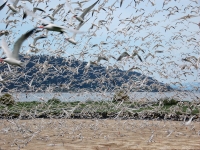forum
library
tutorial
contact

Army Corps of Engineers Looks to
Save Salmon from Caspian Terns
by Annette Cary
Tri-City Herald, March 15, 2012
|
the film forum library tutorial contact |

|
Army Corps of Engineers Looks to
by Annette Cary
|
 The Army Corps of Engineers is considering what to do to give endangered salmon and steelhead a fighting chance against Caspian terns in the Mid-Columbia.
The Army Corps of Engineers is considering what to do to give endangered salmon and steelhead a fighting chance against Caspian terns in the Mid-Columbia.
The birds are nesting at Goose Island at Potholes Reservoir and at Crescent Island just below the mouth of the Snake River.
The Corps is in the early stages of preparing an environmental assessment on managing birds that prey on endangered fish on the Snake and Columbia rivers upstream from the Bonneville Dam.
The bird management that will be proposed for the Mid-Columbia is in addition to the plan to control fish predation by the much larger population of terns downstream in the estuary of the Columbia River, said Lt. Col. David Caldwell, Corps district commander, at a meeting in Kennewick on Wednesday night. About 25 people attended, including government staff.
In addition to the terns at Goose and Crescent islands, American white pelicans and double-crested cormorants also are nesting on other islands near the mouth of the Snake River and eating endangered fish.
But the Corps believes that focusing on the terns on Goose and Crescent islands could have the biggest benefit, said Cindy Boen, project manager for the Corps. Terns on Goose Island fly out to the river and feed on juvenile steelhead, she said.
The Corps has brainstormed a list of options to keep birds, particularly the terns, from eating so many fish, but has not screened them for practicality or effectiveness yet.
That includes developing new tern habitat and moving some of the population there.
That has been done elsewhere by fencing in or getting rid of habitat where terns are living and using decoys and broadcasting tern sounds to entice them to the new habitat, said Ritchie Graves, chief of the Columbia River Power System for the National Oceanic and Atmospheric Administration Fishery Services.
The goal would be to move them to a location where they would feed on fish that are not endangered, Graves said. If habitat is reduced, it would be replaced with twice as much habitat.
Nesting also could be discouraged by hazing the birds, which could be as simple as walking through nesting areas.
Introducing predators is another option. That could include putting up nesting boxes to attract an eagle. Owls, rodents, dogs, weasels and coyotes also can prey on terns or their eggs, Boen said. However, they nest on islands to reduce their exposure to predators.
Killing terns or destroying their eggs also is an option. Although no option has been eliminated, that would be a last resort, Boen said.
Providing an alternate source of food, such as pens of fish, also could be considered. But that is not expected to be effective, she said.
Pelicans are a relatively new arrival to Washington, and the only breeding population is in the Mid-Columbia. Because they are a protected bird in Washington, options for controlling predation by them is limited, officials said.
Studies of where tags from endangered fish are found on land indicate that the cormorants near the mouth of the Snake are eating less fish than the terns are.
A draft of the environmental assessment is expected to be completed in September and the final assessment is expected in December.
Comments about the proposed environmental assessment can be emailed to avian predator@usace.army.mil or mailed to Army Corps of Engineers, ATTN: Avian Predation Management Plan, 201 N. Third Ave., Walla Walla, WA 99362.
learn more on topics covered in the film
see the video
read the script
learn the songs
discussion forum
